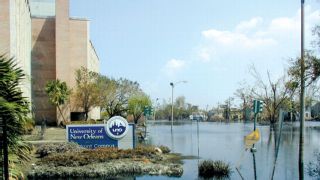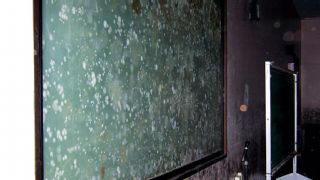On March 11, 2015, the University of New Orleans beat Nicholls State in the first round of the Southland Conference tournament.
It was an insignificant game in the grander landscape of college basketball, but a major milestone for UNO. A school nearly drowned by Hurricane Katrina 10 years earlier, an athletic department targeted for a Division III demotion only six years prior, instead emerged victorious.
The win prompted a major celebration in the locker room, a feeling that not even a loss in the second round of the conference tournament could diminish.
"That was probably one of the best feelings I've had in college so far,'' rising senior Kevin Hill said. "Even after losing that next round, it gave us returners the feeling that the sky is the limit for us.''
Hope.
That's what the players, the athletic department and the university all felt on that March day.
It's also what the city of New Orleans is about now. Ten years after Hurricane Katrina struck, the city's troubles are not entirely gone. They may never be. The people who left, the damage that was done represent more than just numbers and buildings long gone; they represent a culture and a history that can't be replaced.
But it can be restored. The resiliency of today's New Orleans is as much a part of the story as the tragic after-effects of the storm were 10 years ago.
That's what basketball coach Mark Slessinger has been selling to UNO recruits in their living rooms and to players in the locker room.
Hope is what keeps him going and it's what he sees every night when he arrives home. His neighborhood, two miles from the UNO campus, still has a few empty houses in it. A vacant lot sits next door; there was a house there once.
But when he opens the door, Slessinger is greeted by his wife, Toni; his 3-year-old son, Holden; and his 27-month-old daughter.
Her name is Nola.

After detailing what his first four years on the job have been like, Mark Slessinger laughed.
"I figure, if you're going to take on a challenge, you might as well make it a big one,'' he said.
Told he seemed to have exceeded all expectations in that department, Slessinger laughed again.
"Ya think?" he says.
Long after the waters receded, UNO's athletic department remained metaphorically underwater, drowned by bad decisions and indecision, punished for its own mistakes as well as for things it couldn't control. It's nearly impossible to explain in a few tidy sentences what has happened to UNO athletics in the past 10 years.
Here's an attempt:
Immediately after the storm, the teams relocated across the South to practice and compete: the basketball teams to Tyler, Texas; the swim team to Emory University in Atlanta; the baseball team to New Mexico State; the men's golf team to LSU, and the women's golf team to Nicholls State.
Heavily reliant on student fees, the department struggled to make ends meet as thousands of students, like many citizens of New Orleans, simply left and never returned. Before Hurricane Katrina, 17,000 students attended UNO; the year after, just 11,000.
Men's and women's tennis, women's golf, and men's and women's track were suspended as the school grappled to make ends meet, leaving just six sports teams, or eight fewer than the NCAA Division I mandate. The NCAA gave UNO a waiver, allowing until 2011 for the school to restock.
Lakefront Arena, flooded after the roof flew off, was closed for repairs for three years, denying the university and athletic department the $500,000 to $750,000 it made annually off of sporting events, concerts and shows.
The state soon piled on, beginning a decade's worth of defunding higher education. In 2008, the cut came to $15 million alone for UNO.
And then, on Nov. 11, 2009, the university announced it would drop from Division I to Division III and withdrew from the Sun Belt Conference, beginning a dizzying three-year cycle of indecision.
For nearly 18 months after that announcement, the school did nothing, not even joining a Division III league. Suddenly, on March 4, 2011, it announced it would explore the possibility of joining the Gulf South Conference in Division II.
One year later, on March 8, 2012, it reversed course entirely, declaring its intention to remain a Division I program. On Aug. 23, 2012, it joined the Southland Conference.
Of course, to have that resurrection and restore itself as a Division I program firmly and definitively, UNO first had to have died a little bit.
The three years of waffling did exactly that, ultimately damaging the department more than even the storm did.
Derek Morel, who took over as athletic director in 2012, doesn't know how many athletes left in those three lost years. He does, however, know exactly how many stayed.
Six.
That's how many remained from the time UNO announced it would no longer be a Division I school in 2009 to the time it firmly re-entered Division I in 2012.
"I've often said it would have been easier in some ways to get the death penalty,'' said Slessinger, who followed Joe Pasternack as the men's basketball coach in 2011. "You get involved with a recruit and his family pulls out an article from four years ago that has nothing to do with what you are today. You refute that one. Then it's, 'OK. Here's another one,' and you explain, 'No, that was a year and a half ago.' There was never a clear break of, this has stopped, and now we're starting.''

Three years ago, Slessinger and his wife, Toni, decided to become foster parents. They completed the 20 hours of necessary coursework and certification and almost immediately began welcoming children into their home.
Ideally, a foster child is reunited with his or her birth parents, the goal to make the family whole again. The reward, of course, is bittersweet for the foster parents, who have to say goodbye to a child they've nurtured and cared for.
It is a job, or more accurately, a vocation that is a true labor of love.
Slessinger, 41, views his position at UNO much the same. There are plenty of easier gigs than this one -- his three predecessors all left to become assistants -- but he believes the reward is in the work.
"It's kind of corny, but my wife and I believe we can make a difference being here,'' he said. "You have to be invested to do this. It's more than just going to talk to a Rotary luncheon. You've got to make real relationships, shake people's hands and let them know you're here. I honestly think we can win and really make an impact, not just on our kids but on our city.''
That's not to say there aren't days that Slessinger and everyone else associated with the school doesn't feel a bit like Sisyphus -- keep pushing the boulder up the hill, only to watch it tumble back down.
Keeping UNO athletics afloat, let alone as a Division I program, is like pushing 12 boulders uphill. President Peter Fos, himself a UNO graduate, is the man who made the decision three years ago to remain as a Division I program.
His reasoning was simple.
"We have a legacy of being a Division I program in a major sports event city, with a football team that won a Super Bowl, with an NBA franchise that's up and coming,'' Fos said by way of explaining his commitment to athletics. "Why in the world wouldn't you want the university with the city namesake to play at the highest level?"
But staying at the highest level isn't easy or cheap. With the dwindling student population -- the state recently mandated tougher admission standards, limiting the pool even further; the current enrollment is 9,300 -- and the budget cuts, athletics receives virtually no money from the general fund.
Yet to remain as a Division I program, the school needs to maintain 14 sports and the administrative staff to support them.
Morel uses creativity to combine endowment money, sponsorships and fundraising to pay the bills.
"I've worked the gamut, from large state school to small private and everything in between, and I've never run into the adversities I ran into here,'' Morel said.
Worse is trying to anticipate what might be around the corner.
Slessinger's first game as a college head coach was at New Mexico. At the time, the university hadn't even announced its intention to return to Division I. He knew his players weren't ready or able to compete against Division I players, so the 52-point loss didn't surprise him.
What came next did. The NCAA slapped the men's basketball program for underperforming academically, handing out so-called Level 3 Academic Progress Rate (APR) sanctions that included a reduction in practice time, recruiting restrictions and postseason bans.
The school appealed, citing the upheaval within the school and the athletic department, but was denied.
"The cumulative effect of that was just devastating,'' Slessinger said.
The biggest battle, though, was and continues to be perception and trust.

The Privateers all but disappeared from the public consciousness for those three lost years of indecision. And now that they are back, folks understandably aren't sure if they are going to stick around.
This year, New Orleans averaged just 725 people per home game in its cavernous 8,700-seat arena.
"People moved on to other things,'' Morel said. "We have a large alumni base in this city. I don't know if they weren't firmly attached before, but for whatever reason it was easy to let it go. The roots weren't deep enough to survive what happened, to get them to invest their hard-earned money. That's really what we have to change.''
The hope, of course, is that the win in the Southland Conference tournament is the beginning of that change.
This past season, after all, marked the closest thing to normal Slessinger has known as a head coach. With a full allotment of schedules and no more APR penalties, Slessinger could finally get about the business of coaching.
"As a staff this past year, we'd look at the calendar and say here's our one day off, now where's the second? And then we'd stop and realize we don't have to do that,'' Slessinger said. "For a gym rat like me, it was Christmas. You mean I get to spend another day with these guys? It was such a sigh of relief. It finally feels like, 'Ok. We're here. Let's do this.' ''
Nine years ago, Slessinger was an assistant at Northwestern State when the Demons upset Iowa in the first round. He remembers the sweetness of that moment, the pride sprinkled over the school and fan base from that one victory.
Maybe once he thought it would be impossible to imagine something more fulfilling.
Now he knows better. A packed room, that would be better, one filled with his basketball players, their families, fans and administrators, all tuned to the television on a Sunday in March.
And then there it is, the University of New Orleans' name on a line in the NCAA tournament bracket.
"It would be, I don't know, it would be amazing. To be able to come back from the greatest natural disaster this country has ever known and everything else we've been through, to me it would be the greatest validation,'' Slessinger said. "If we could pull it off, we could write a great chapter to this story.''
It would be about more than a basketball team or a school or even a city.
It would be about hope.
It would be about Nola.

